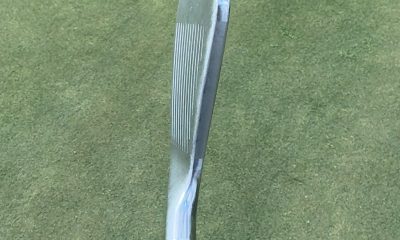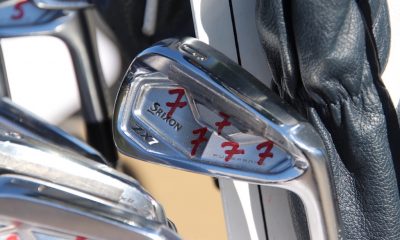Opinion & Analysis
Head to Head: Callaway Apex CF ’16, Mizuno JPX-900 Forged and Srixon Z565 irons

A few weeks ago, GolfWRX Members voted for the three game-improvement irons they most wanted to see tested head-to-head. The winners were: Callaway Apex CF ’16, Mizuno JPX-900 Forged and Titleist 716 AP1. Unfortunately, I was not able to access a Titleist 716 AP1 at my desired specs (62-degree lie, 32-degree loft), so it was replaced in the test by the iron that got the next highest amount of votes, Srixon’s Z565 irons.
I do a lot of these head-to-head equipment test videos on my YouTube Channel, but for this video I stepped it up. Each of the three irons were tested with the same shafts of the exact same length, and all the clubs had the same grips, lofts, lies and swing weights, courtesy of Tour X Golf fitters.
As always, post your comments and questions below.
Related
- Head to Head: Mizuno MP-5, PXG 0311T and Titleist 716 AP2 irons
Opinion & Analysis
The 2 primary challenges golf equipment companies face

As the editor-in-chief of this website and an observer of the GolfWRX forums and other online golf equipment discourse for over a decade, I’m pretty well attuned to the grunts and grumbles of a significant portion of the golf equipment purchasing spectrum. And before you accuse me of lording above all in some digital ivory tower, I’d like to offer that I worked at golf courses (public and private) for years prior to picking up my pen, so I’m well-versed in the non-degenerate golf equipment consumers out there. I touched (green)grass (retail)!
Complaints about the ills of and related to the OEMs usually follow some version of: Product cycles are too short for real innovation, tour equipment isn’t the same as retail (which is largely not true, by the way), too much is invested in marketing and not enough in R&D, top staffer X hasn’t even put the new driver in play, so it’s obviously not superior to the previous generation, prices are too high, and on and on.
Without digging into the merits of any of these claims, which I believe are mostly red herrings, I’d like to bring into view of our rangefinder what I believe to be the two primary difficulties golf equipment companies face.
One: As Terry Koehler, back when he was the CEO of Ben Hogan, told me at the time of the Ft Worth irons launch, if you can’t regularly hit the golf ball in a coin-sized area in the middle of the face, there’s not a ton that iron technology can do for you. Now, this is less true now with respect to irons than when he said it, and is less and less true by degrees as the clubs get larger (utilities, fairways, hybrids, drivers), but there remains a great deal of golf equipment truth in that statement. Think about it — which is to say, in TL;DR fashion, get lessons from a qualified instructor who will teach you about the fundamentals of repeatable impact and how the golf swing works, not just offer band-aid fixes. If you can’t repeatably deliver the golf club to the golf ball in something resembling the manner it was designed for, how can you expect to be getting the most out of the club — put another way, the maximum value from your investment?
Similarly, game improvement equipment can only improve your game if you game it. In other words, get fit for the clubs you ought to be playing rather than filling the bag with the ones you wish you could hit or used to be able to hit. Of course, don’t do this if you don’t care about performance and just want to hit a forged blade while playing off an 18 handicap. That’s absolutely fine. There were plenty of members in clubs back in the day playing Hogan Apex or Mizuno MP-32 irons who had no business doing so from a ballstriking standpoint, but they enjoyed their look, feel, and complementary qualities to their Gatsby hats and cashmere sweaters. Do what brings you a measure of joy in this maddening game.
Now, the second issue. This is not a plea for non-conforming equipment; rather, it is a statement of fact. USGA/R&A limits on every facet of golf equipment are detrimental to golf equipment manufacturers. Sure, you know this, but do you think about it as it applies to almost every element of equipment? A 500cc driver would be inherently more forgiving than a 460cc, as one with a COR measurement in excess of 0.83. 50-inch shafts. Box grooves. And on and on.
Would fewer regulations be objectively bad for the game? Would this erode its soul? Fortunately, that’s beside the point of this exercise, which is merely to point out the facts. The fact, in this case, is that equipment restrictions and regulations are the slaughterbench of an abundance of innovation in the golf equipment space. Is this for the best? Well, now I’ve asked the question twice and might as well give a partial response, I guess my answer to that would be, “It depends on what type of golf you’re playing and who you’re playing it with.”
For my part, I don’t mind embarrassing myself with vintage blades and persimmons chasing after the quasi-spiritual elevation of a well-struck shot, but that’s just me. Plenty of folks don’t give a damn if their grooves are conforming. Plenty of folks think the folks in Liberty Corner ought to add a prison to the museum for such offences. And those are just a few of the considerations for the amateur game — which doesn’t get inside the gallery ropes of the pro game…
Different strokes in the game of golf, in my humble opinion.
Anyway, I believe equipment company engineers are genuinely trying to build better equipment year over year. The marketing departments are trying to find ways to make this equipment appeal to the broadest segment of the golf market possible. All of this against (1) the backdrop of — at least for now — firm product cycles. And golfers who, with their ~15 average handicap (men), for the most part, are not striping the golf ball like Tiger in his prime and seem to have less and less time year over year to practice and improve. (2) Regulations that massively restrict what they’re able to do…
That’s the landscape as I see it and the real headwinds for golf equipment companies. No doubt, there’s more I haven’t considered, but I think the previous is a better — and better faith — point of departure when formulating any serious commentary on the golf equipment world than some of the more cynical and conspiratorial takes I hear.
Agree? Disagree? Think I’m worthy of an Adam Hadwin-esque security guard tackle? Let me know in the comments.
@golfoncbs The infamous Adam Hadwin tackle ? #golf #fyp #canada #pgatour #adamhadwin ? Ghibli-style nostalgic waltz – MaSssuguMusic
Podcasts
Fore Love of Golf: Introducing a new club concept

Episode #16 brings us Cliff McKinney. Cliff is the founder of Old Charlie Golf Club, a new club, and concept, to be built in the Florida panhandle. The model is quite interesting and aims to make great, private golf more affordable. We hope you enjoy the show!
Opinion & Analysis
On Scottie Scheffler wondering ‘What’s the point of winning?’

Last week, I came across a reel from BBC Sport on Instagram featuring Scottie Scheffler speaking to the media ahead of The Open at Royal Portrush. In it, he shared that he often wonders what the point is of wanting to win tournaments so badly — especially when he knows, deep down, that it doesn’t lead to a truly fulfilling life.
View this post on Instagram
“Is it great to be able to win tournaments and to accomplish the things I have in the game of golf? Yeah, it brings tears to my eyes just to think about it because I’ve literally worked my entire life to be good at this sport,” Scheffler said. “To have that kind of sense of accomplishment, I think, is a pretty cool feeling. To get to live out your dreams is very special, but at the end of the day, I’m not out here to inspire the next generation of golfers. I’m not out here to inspire someone to be the best player in the world, because what’s the point?”
Ironically — or perhaps perfectly — he went on to win the claret jug.
That question — what’s the point of winning? — cuts straight to the heart of the human journey.
As someone who’s spent over two decades in the trenches of professional golf, and in deep study of the mental, emotional, and spiritual dimensions of the game, I see Scottie’s inner conflict as a sign of soul evolution in motion.
I came to golf late. I wasn’t a junior standout or college All-American. At 27, I left a steady corporate job to see if I could be on the PGA Tour starting as a 14-handicap, average-length hitter. Over the years, my journey has been defined less by trophies and more by the relentless effort to navigate the deeply inequitable and gated system of professional golf — an effort that ultimately turned inward and helped me evolve as both a golfer and a person.
One perspective that helped me make sense of this inner dissonance around competition and our culture’s tendency to overvalue winning is the idea of soul evolution.
The University of Virginia’s Division of Perceptual Studies has done extensive research on reincarnation, and Netflix’s Surviving Death (Episode 6) explores the topic, too. Whether you take it literally or metaphorically, the idea that we’re on a long arc of growth — from beginner to sage elder — offers a profound perspective.
If you accept the premise literally, then terms like “young soul” and “old soul” start to hold meaning. However, even if we set the word “soul” aside, it’s easy to see that different levels of life experience produce different worldviews.
Newer souls — or people in earlier stages of their development — may be curious and kind but still lack discernment or depth. There is a naivety, and they don’t yet question as deeply, tending to see things in black and white, partly because certainty feels safer than confronting the unknown.
As we gain more experience, we begin to experiment. We test limits. We chase extreme external goals — sometimes at the expense of health, relationships, or inner peace — still operating from hunger, ambition, and the fragility of the ego.
It’s a necessary stage, but often a turbulent and unfulfilling one.
David Duval fell off the map after reaching World No. 1. Bubba Watson had his own “Is this it?” moment with his caddie, Ted Scott, after winning the Masters.
In Aaron Rodgers: Enigma, reflecting on his 2011 Super Bowl win, Rodgers said:
“Now I’ve accomplished the only thing that I really, really wanted to do in my life. Now what? I was like, ‘Did I aim at the wrong thing? Did I spend too much time thinking about stuff that ultimately doesn’t give you true happiness?’”
Jim Carrey once said, “I think everybody should get rich and famous and do everything they ever dreamed of so they can see that it’s not the answer.”
Eventually, though, something shifts.
We begin to see in shades of gray. Winning, dominating, accumulating—these pursuits lose their shine. The rewards feel more fleeting. Living in a constant state of fight-or-flight makes us feel alive, yes, but not happy and joyful.
Compassion begins to replace ambition. Love, presence, and gratitude become more fulfilling than status, profits, or trophies. We crave balance over burnout. Collaboration over competition. Meaning over metrics.
Interestingly, if we zoom out, we can apply this same model to nations and cultures. Countries, like people, have a collective “soul stage” made up of the individuals within them.
Take the United States, for example. I’d place it as a mid-level soul: highly competitive and deeply driven, but still learning emotional maturity. Still uncomfortable with nuance. Still believing that more is always better. Despite its global wins, the U.S. currently ranks just 23rd in happiness (as of 2025). You might liken it to a gifted teenager—bold, eager, and ambitious, but angsty and still figuring out how to live well and in balance. As much as a parent wants to protect their child, sometimes the child has to make their own mistakes to truly grow.
So when Scottie Scheffler wonders what the point of winning is, I don’t see someone losing strength.
I see someone evolving.
He’s beginning to look beyond the leaderboard. Beyond metrics of success that carry a lower vibration. And yet, in a poetic twist, Scheffler did go on to win The Open. But that only reinforces the point: even at the pinnacle, the question remains. And if more of us in the golf and sports world — and in U.S. culture at large — started asking similar questions, we might discover that the more meaningful trophy isn’t about accumulating or beating others at all costs.
It’s about awakening and evolving to something more than winning could ever promise.






















sumsum
Nov 16, 2016 at 6:23 pm
Rick,
It seems you Averaged 4mm toe on the Apex, and 5mm toe on the srixon – and the shots all went left….. Mizuno averaged 1mm toe and actually dispersed tighter to the line, not all grouped left. Also, you had 1.4deg and 1.6 deg of side spin with the Callaway and Srixon respectively, vs. 3.6 degrees of side spin with mizuno. This could’ve held it from achieving more distance, but more like it seems, it was third in your test, and you miss hit it more often as you tired. I would like to see you stagger the test, 1 callaway, 1 srixon, 1 mizuno…etc to produce a real test. Also, Mizuno is the only full forged head in the group – the other are multi-material constructions.
Tom
Nov 17, 2016 at 11:30 am
Huh? and there it is. ….to the rescue.
Tom
Nov 16, 2016 at 2:23 pm
Are we gonna get “impact” comments again?
Tom
Nov 16, 2016 at 2:01 pm
Wait for it……wait…… for …… it…….
Jim
Nov 16, 2016 at 1:03 pm
It doesn’t matter what the loft is. The COG and even proscribed shaft the engineers (occasionally) designed it around to produce the loft needed for the ‘X’ to play as it should. A (‘7’) iron needs to achieve a ball flight apex to land softly. If it does and yields more distance then they did thier job – well.
In ’97 I played Diawa Comps. Took a bit of ‘getting used to’
as they looked like shovels compared to my Miura’s, TZoids
or VIP’s but the thin Titanium face and sharp grooves
allowed for Tungsten inserts to lower the CG enough they
went plenty high, stopped dead with 5irons or got nice draw with a 6 on the greens and were almost 20yds longer. A well needed boost following 3 fractured vertibrea and lead shoulder/hand injuries.
Everyrhing has changed dramatically in 40 years. Jack coulda hit a 200yd 7 iron back then, it just never would of stopped on the green. Even most ‘players’ clubs PW have gone from 48 to 46 or 46.5 because the balls & shafts and better head design allow for it.
Great work running these tests – and yes, even the grip should be the same. The heads however should be checked to be exact MFR lofts – whether or not there’s a difference between the club’s designated ‘number’…the launch data will tell us if one has been made ‘too strong’ and comes into a green too hot.
thanks for doing these 🙂
Jack
Nov 16, 2016 at 8:11 am
So what you are saying is a lot more people are striping 2 or even 1 irons down the fairway nowadays. Amazing.
Philip
Nov 15, 2016 at 10:40 pm
I like that you are getting away from numbers on the clubs as that loft was called a 5 iron when I started playing golf. You shouldn’t even mentioned the marketing number on the bottom of the club, but if someone needs to think that they hit their club with a 7 on it the same distance as my club with a 5 on it – whatever turns their crank. What was the length of the irons? All 37 inches?
Brian
Nov 16, 2016 at 10:12 am
I get so sick of listening to people complain about the loft vs. Number on the bottom of your club. Nobody cares what the 5i was back in your day…you also walked to school in the snow, uphill, both ways.
I bet your 5 iron of yester-year didn’t launch the ball as high as the current 7 irons.
Philip
Nov 16, 2016 at 11:34 am
Wow – hit a nerve eh? Didn’t know back in the day was only 5 years ago – what, you age in dog years? Chill dude – reviewing taking about lofts inside of what has become a meaningless number only makes it easier to compare apple to apples. Oh, and a higher launch isn’t always needed or better – horses for courses.
Spanky
Nov 16, 2016 at 10:58 am
You score is what counts in golf, right? If it makes you feel better to have a “traditional” lofted 7 iron, go for it. I see no difference though in someone wanting a non “traditional” 7 iron, than what you want and as long as fitted for the clubs. It makes zero difference. Heck, you are free to use a persimmon 1 wood with a 20 year old steel shaft if that makes you feel better. Just hit the ball and have fun. If it worries you that someone says they hit their 7 iron longer than your 7 iron, eh, I think you just need to let it go and learn to give jabs right back about something else.
For kicks though, go take a 7 iron from decades ago and get on trackman and compare to these newer lower lofted 7 irons. I think you’ll quickly understand the reasons for lower lofts these days vs more traditional lofts. If that doesn’t make sense to you, then go bend the loft down on a 20 year old 7 iron to match today’s lofts (~30 degrees) and see what you get on the course. Let me know how those bullets work out as they only go a few yards off the ground and skid off the back of a green. It is more than just the loft.
No matter how you look at it, everyone has to hit the club and post a score no matter what is stamped on the club. And if you really think about it, there is no “standard” loft any longer.
And beyond lofts, the is no standard on what “regular”, “stiff” etc. means in shafts yet many take it for granted those all mean the same thing across manufacturers. They don’t.
Get fitted. If you end up with a 35 degree 7 iron, bravo. If its 28 degrees, bravo as well.
Philip
Nov 16, 2016 at 11:53 am
Another nerve pinched :o) – for the record I have been getting fitted for a while and have ended up with clubs from 2006 that are only “one” number behind the current crop and from what I see there never was a standard so why even bother with random numbers on clubs. Personally I couldn’t care less about the numbers because in the end I decide on clubs via lofts to space my yardages. However, the effect of the decreased lofts and increased lengths just means I have to tweak lofts more than before and add more lead tape than before after cutting down the shaft lengths, as the OEMs use lighter heads to prevent the swing weights from getting to heavy with the longer lengths. My club selection is based on what I need to get my lowest score. I don’t care about the numbers on my clubs, I figure out the lofts that work – my 3W is the length of a 2W (42.5 inches) with the loft of a 4W (18), or is that a 7W now… I don’t care, as in the end all I need is to figure out the length/loft combination that maximizes my potential – the numbers on the clubs are irrelevant other than to make it easier to pull a club. Only makes it a bit trickier when looking for clubs to replace worn out ones.